Paragliding One-O-One: Nepali-style
November 27, 2011 Shem Radzikowski 5 Comments
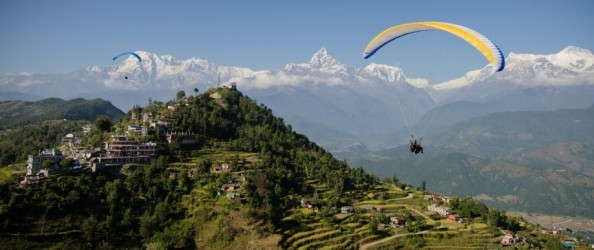
What a rush to finally do it on my own! Paragliding might look graceful, adventurous and exciting, but before you get anywhere near to using those fascinating words, there are a lot of boring ones you need to internalise first. Words like: fatigue, frustration, control, emotion, theory and patience pretty much sum up the first few days.
Paragliding in Pokhara
With only one introductory tandem flight (lasting about 3 minutes) under my belt, I decided to venture into unknown territory and learn how to fly for myself. Granted, the 3 minutes didn’t really prepare me from a practical or theoretical side, but it did introduce me to a new way of augmenting my hiking — climb to the top of a mountain and then fly down.

Evening shot of Phewa lake from Pokhara shoreline
With this in mind, I packed my bags and travelled to Pokhara, Nepal. The first reason I chose Nepal was because my brother was already working there as a tandem pilot, and since I hadn’t seen him in almost a year, it was the perfect excuse. Secondly, what better way to celebrate my birthday :)
Mental note to self: If you work in the developing countries, avoid holidaying in such places without first taking a sanity break somewhere else. The pollution, noise, inefficiencies and harassment can make the whole experience less relaxing than it could have been.
Don’t get me wrong, Nepal is an awe-inspiring place that everyone should see at least once in their life, but sometimes it’s nice to take rest in the comfort of your own backyard.
Day One: Mountainous Rain Clouds
5 November, 2011
On day one in Pokhara we had bigger problems to contend with. Mountainous rain clouds blanketed the sky in all directions and completely blocked out any hint of blue. By 9am we were told by the course instructor to come back an hour later to see if weather conditions improve enough for us to go out to the training field. Faced with a flop of a first day, we retreated to drown our sorrows in a pot of Masala Tea.
“Namaste,” the lovely owner at New Beautiful Café would say. Everyone here is so warm, friendly and welcoming. It’s not at all a surprise why so many stay longer than they originally planned.
The gesture Namaste represents the belief that there is a Divine spark within each of us that is located in the heart chakra. The gesture is an acknowledgment of the soul in one by the soul in another. “Nama” means bow, “as” means I, and “te” means you. Therefore, Namaste literally means “bow me you” or “I bow to you.”
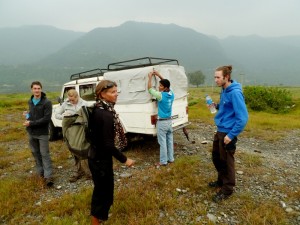
Training Ground
An hour later, the ground had dried somewhat and the temperature increased by a fraction. Not perfect by any stretch of the imagination but at least we’d be able to start with some basic ground handling. More importantly, judging by the cloud cover it didn’t look as though we’d have any more rain that day. We packed the 4WD with our trainer gliders and drove along the bumpy road to the beginner ground.
It was nice to get into the serene countryside and leave behind a city which during the day is awash with diesel-spewing trucks and motorcycles whose deafening beepers activate at every pothole, car and cow.
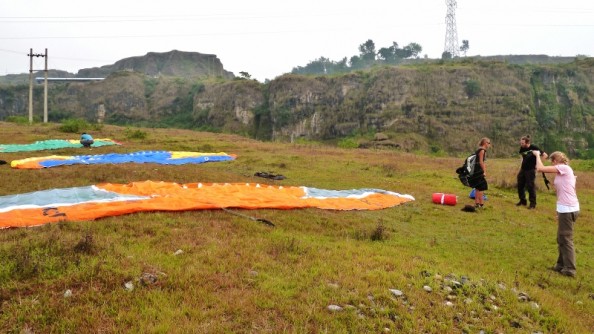
Preparing our gliders
The beginner ground was a grass-covered field sloping gently towards a valley whose river had over thousands of years exposed large boulders on either bank. Separating us from the river was a sheer cliff and I remember thinking that it would be quite easy to miscalculate and fly over by accident. High above our heads, vultures circled and were already showing off their soaring talents by climbing higher and higher within the thermals on their enormous two-metre wings.
After assessing the weather conditions, wind direction, familiarising ourselves with the equipment and conducting a safety check, we waited patiently for steady wind. A-lines and the Brakes at the ready, one by one, we all stepped forward, inflated the wing and ran as quickly as we could towards the bottom of the field.
Sabrina, our French instructor, said that “flying a glider is like driving a car, to turn left you pull on the left brake and raise your right. To turn right, you pull on the right brake and release the left.” But putting theory into practice is usually the bit that requires repetition.
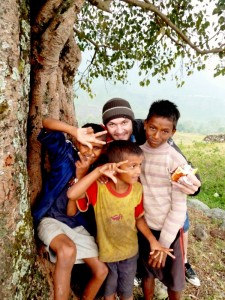
Hiding from the rain
“Left brake! Left brake!!” she would yell, giving us enough feedback so that we could steer the glider and begin to understand the basics of control.
Running with a 28 square meter sail strapped to your back is like trying to run in shoulder-high water. Every step you take forward is very unproductive until you manage to understand the relationship between the brake lines and the pressure you exert on the glider.
Some attempts were successful whilst others turned into wind-flapping disasters even before the second step. We made slow but steady progress right up until the skies let loose more rain, forcing us to retire for the day.
Day Two: Control and Temperance
6 November, 2011
Building on the practical knowledge from the previous day, we had a deeper theoretical session on glider dynamics and control. The exhausting practical experience, hundreds and hundreds of meters of sprinting, frustration and somewhat control of the glider had given us a greater understanding of our role in this flying pendulum.
Today, more running but with improved control and awareness of the wing; where it wants to fly and how you should not only apply the brakes but also where your body should be in relation to the wing’s position. I had a number of good sessions and was able to take control of the glider all the way to the bottom of the field, although I still have some work to do in controlling the wing just after the beginning.
Eventually we started hearing “run my little bird,” instead of “STOP!” Everyone showed much higher levels of improvement but more importantly we’d regained the confidence lost during the first day of mishaps. In light of today’s performance, our instructor thinks that we might be ready for a short flight tomorrow. Our practical training was once again cut short because of rain.
The evening theoretical session focussed on thermals, wind, drag and weather within a mountainous region. Pokhara is very popular with paraglider pilots because it has relatively stable and predictable flying conditions for most of the year and that this weather we’re heaving is very unusual for November.

Study time - Paragliding 101
Day (null): Weather Turns to Shit
7 November, 2011
Even before breakfast, it was obvious that the bad weather wasn’t going to let up. Our training got cancelled and we need to wait till next morning before continuing with the course. On the bright side though, at least we’ll have a break after the two days of running around like idiots with a kite strapped to our backs.
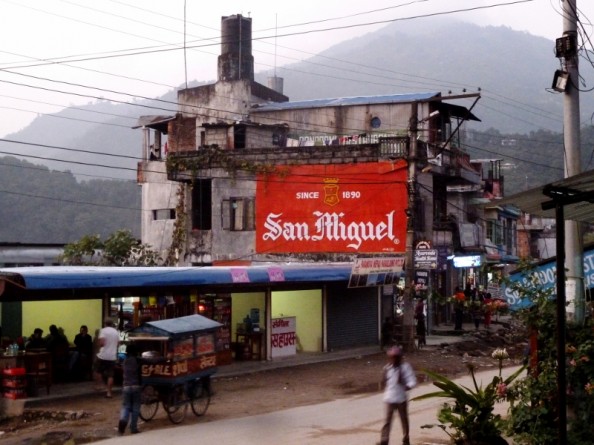
Lakeside in Pokhara
By mid-afternoon the weather had improved enough that some pilots were heading up to Sarangkot. Not wanting to let the whole day go to waste, Stan suggested we grab the tandem and go up for a quick glide. By the time we arrived at take-off, it seemed as though every other pilot had had the same idea — after almost five days of poor conditions — the skies were filled with gliders and each one scratching around within the house thermal for some additional lift.

Out on the tandem
It didn’t take too long for the grey clouds to take back the skies. Our landing was far from perfect, in fact, with so many pilots coming in at the same time it was difficult to judge who had right of way. The shifting wind caused us to take the land route and we lost far too much height approaching from behind the new hotel complex. Luckily though, we made it over the power lines and set down with one foot on grass and the other in a stream.
Day Three: Ground Handling and on Slope Soaring
8 November, 2011
I must admit that our progression from day to day has been quite amazing. We’re actually able to construct (inflate) the wing, control it (more or less) and then run along a planned trajectory without allowing it to overtake us or fall behind. Still, the level of strength and force required to inflate the wing is a bit of a hit and miss affair, but I’m sure that with some more practice our judgement will improve.
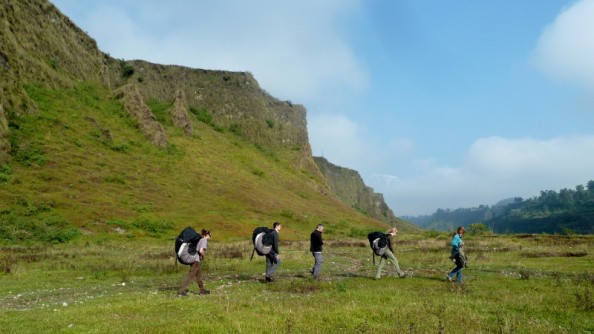
Hike to Training Slope
Today was our first day of constructing the wing on a slope — drastically increasing the inflation rate — followed by a 10-15 metre flight. Yes, that’s right — an actual flight where the wing suspends your full weight in the harness and feet leave the ground. After a few tries we were all up in the air. I couldn’t say skilfully, not just yet, but one by one we showed consistent improvement on inflation and flight.
I think on my second short flight, I remember hitting a gust of air which gave me an upward and sideways boost that shifted my attention to the canyon directly to my left. Not a large canyon, but with only a few short solo flights under my belt, even small imperfections on landing seemed like giant obstacles.
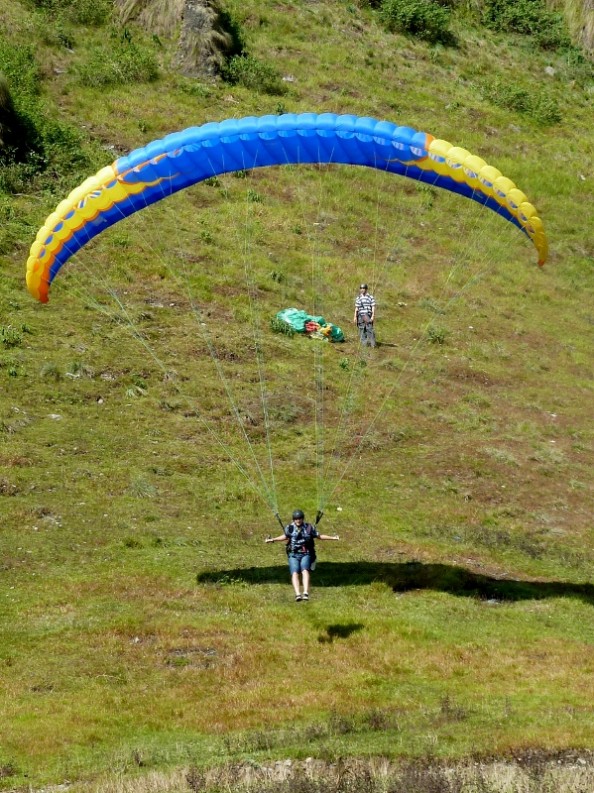
Feet leave the ground
“Shem, I’m still not happy with your take off,” Sabrina would say over the radio. She was right. For some reason somewhere in the back of my mind there was this notion that the wing won’t fly without a strong start. In fact, the truth is that a gentle start helps you control the wing and gives you more time to assess whether it’s properly inflated, if there are any knots in the lines and whether it’s still a good idea to take off or stay put.
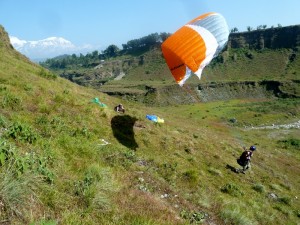
Perfect Wing
It seems that women are far more successful at mastering the art of paragliding because of their tendency to do things with a bit more grace and gentleness. They tend to rely on technique rather than brute strength to achieve the objectives — something that us men will need to unlearn after basic training.
Our two instructors had a short meeting to decide whether our flight on the slope was at a level where they feel comfortable of taking us higher. And apparently so, because that afternoon we drove out to an open area that would serve as our landing field the following two days.
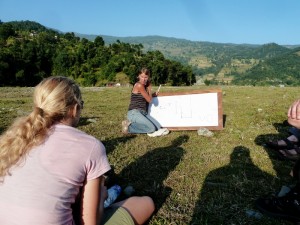
Theory in the Field
We sat huddled around a whiteboard discussing tactics for landing, baseline approach, figure-of-eight’s, minimum sink and other terms which at the time seemed insignificant in comparison to the mountain (Madredunga) we’d all be launching from the next morning.
We were surrounded by rice fields in three directions and I toyed with the idea of an emergency landing in a soft rice paddy. The afternoon sun was still warm and gave each one of us a healthy glow while we absorbed the surroundings and all that was to come.
To go from 10m to 800m in one short day seems rather intimidating, especially when sitting at the foot of mountain (my brother calls Madredunga a hill) that towers above you. Although our instructors seemed to think that the hardest part of our training was actually over — ground handling and wing control were paramount to good take off — once you’re up in the air you can sit back, relax and enjoy the view.
Day Four: Madredunga – First Flight
9 November, 2011
I didn’t sleep well that night — paragliding jargon rattling around my head. But I wasn’t at all stressed about the flight, quite odd considering that this would be my first real solo flight — credit of my instructors I think. They both did an exceptional job in conveying theory and instilling in us self-confidence.
“If you get into trouble, raise your arms and release the brakes,” Sabrina would say, “the glider, he knows how to fly better than you.”
The conditions were perfect, full visibility in all directions. You could almost hear the smiling faces of tandem pilots who — after a week of depressing weather — were once again walking with a joyful spring in their step. All of Pokhara was smiling today, almost as if the town atmosphere has a symbiotic connection with the paragliders.
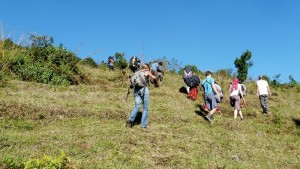
Climbing Madredunga
The jeep could only get us two thirds up Madredunga and we needed to walk the rest of the way. We stopped at a small village directly below the take-off field. It would still be another thirty minutes of hard hiking to get to the top. The villagers swarmed around the jeep wanting to make some extra cash by carrying our gliders to the top for sixty rupees. Their cardio-vascular systems are far more adept to functioning at these heights; and even though we’re only at 1,800m it makes a huge difference. Boys and girls half my height were virtually running up the mountain while carrying our gear and it was quite depressing to see how badly my fitness had deteriorated since my knee operation a year ago.
I decided to take my glider to the top by myself — in hindsight, it was probably a stupid thing to do because I was exhausted by the end of it. It was tough work and the sun wasn’t making it any easier. I’m officially calling Paragliding a sport from here on in.
The view on top was simply breathtaking and we had a chance to bask in all of Nepal’s splendour. For the first time since arriving I felt as though this was the real Nepal I’d heard, read and dreamed of. The roof of the world.

View from Madredunga
For me, climbing to the top of a mountain is synonymous with escaping mankind, the daily grind and gives one a unique perspective on life. Today reminded me of climbing to the top of a mountain in Fiji many years ago — the moment so clear and crisp in my mind still to this day — that I use it as a benchmark against which to measure the clarity of my life.
For some peculiar reason though, only vertical distance from life and problems exhibits this trait. Unsurprisingly then, why so many Buddhist monasteries are high up in the mountains. Maybe we start to see the world, mankind and their/our problems as insignificant compared to the bigger picture.
Our Scottish instructor, Maurice, flew off first to show us the direction we should be flying in. Once he was down at the landing site it was time for us to get started. One by one we opened up our gliders, checked the lines and radios and waited for the next cycle of warm air.
“Shem, whenever you feel ready,” Sabrina said standing in front of me, “radio check for Shem.” Both hands gripped the risers, the radio up so loud I’d hear it in my grave — finally the warm gentle wind started to blow. I took two steps and already felt plenty of pressure on my chest-strap — the glider was up. The radio amplified Sabrina’s voice, “Run! Run! Run!” — and so I did.
Within seconds my feet were off the ground, the glider lifting me higher into the sky and Sabrina on the radio giving me instructions. “Okay Shem, now move your legs side to side if everything is fine — good, enjoy the flight and Maurice will talk to you when you get closer to the landing field.” From time to time she would tell me to correct my heading but otherwise that was it. I was on my own and airborne.
The whole thing felt like a dream, an out of body experience. When my body relaxed enough to sit in the armchair-like harness, my eyes started to admire the pristine surroundings Snow-capped mountains, tiny villages, dried up riverbeds cutting through valleys, trees, rice paddies, people washing their hair — it was such a surreal and vivid moment that I’ll never forget it. I think it may have been mild shock, but in a good way.
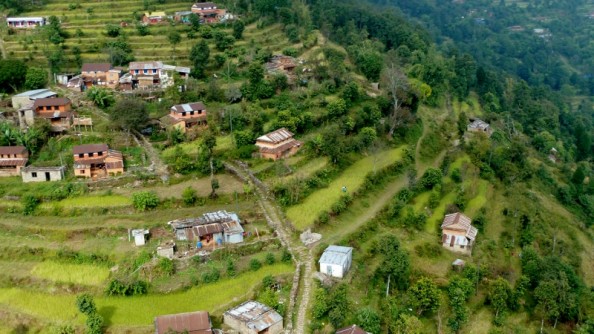
View of village and rice paddies
My landing was rougher than anticipated — I’d found the only rocky area on the field — but I was down safely. Maurice did a great job of talking me down over the radio, never raising his voice, always calm and reassuring. With my glider bunched up and over my shoulder I made my way towards the other side of the field where everyone else was already waiting.
The twenty minute flight seemed more like a few seconds and I was already thinking of doing it again — only next time I give the glider to the porter and save my strength for the flight. Why would anyone ever walk again when you can fly? It wasn’t until this moment I understood why my brother fell in love with the sport and why he’s still so passionate about it; and believe me, being a passenger on a tandem is nothing compared to flying your own glider.
Given the time that it takes to get to the top we’d only have enough time for one more flight today. This time we did pitch control exercises. My second take off was fine but I’d let out the brakes too high and came in a bit too fast. I’m sure mastery will come with time and practice.

Windsock at the landing site
We were all on a high and wanted to celebrate our momentous achievement — drinks at the Landing Zone café (on me). That evening we too walked with a spring in our step. For the first time ever we felt part of the paragliding community. We’d flown, we’d experienced and we’d never look at a valley, city or mountain in the same way again; our eyes and perspective had changed — and we wanted more. I couldn’t have asked for a better birthday present.
Day Five: Roll Control & Big Ears
10 November, 2011
Today I didn’t hesitate at all and gave my glider to the first available porter. I took my time getting to the top and made a conscious effort to look around more and take in the scenery.
The instructors did a swap today, Sabrina at the landing site while Maurice guided us at take-off. “Be the last one on the first flight and the first on the last,” said my brother during breakfast. That way you’ll get the best thermals and flight time.
And so it was, the first take-off was quite effortless and I was in the air quite fast. There was a lot more turbulence in the air and at various moments I was visibly going up rather than down. Today was far more relaxed. With the first flight under our belts, it was time to enjoy the view and relax.
The first flight was also supposed to tackle roll control exercises. When I was over the landing field, Sabrina talked me through the procedure to roll the glide side to side using my weight. It was actually a lot of fun, a bit like sitting in your own roller-coaster.
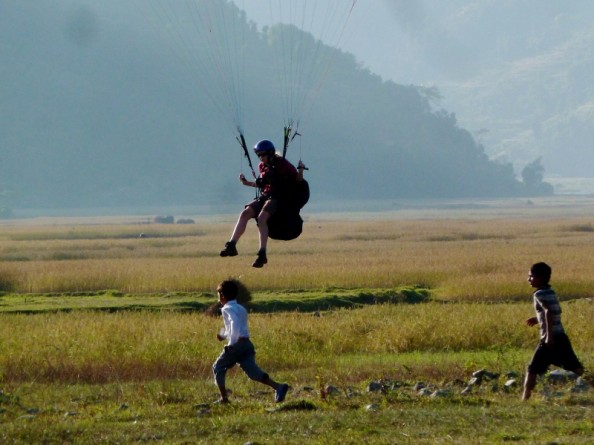
Kids rushing to help with the packing - bargain at only Rs 20
My landing approach was good, but we had a small communication problem and I overshot the field only to land in a rice paddy. As I’d suspected, it was much softer to land here than on the rocks :) I picked up my glider and ran back to the landing site. Luckily, none of the farmers saw me and there was no fine. The standing rate for landing in a rice paddy is about Rs 500.
After a quick meal we were back on the mountain again. Our accomplishments further uplifted the euphoric feelings. Sticking to what my brother told me — last on first and first on last — my glider was ready to go. “Ok, Shem — go!”
I was all over the place. The small crosswind caused me to zigzag across the take-off but the glider was fully inflated and Sabrina gave me the green light to run. The flight was so peaceful that I quickly forgot about the dismal start. The sun was in my face and the wind was blowing gently directly at me. I wanted to break away from the flight plan and go cross-country on my own. Ok, maybe just a quick 360? Of course, I did no such thing and kept strictly to the flight plan.
During this flight we would practice the big-ears descent technique which requires you to collapse the outside edges of the wing in on itself. We do this by pulling down on the A-risers until the wing edges flop down under the main wing. It was really easy, no need to pump the brakes, the glider reinflated on its own just as our teachers had predicted.
My last landing was perfect, almost effortless and with zero impact. My feet touched the ground so softly that it could have been water. I can’t say that I’d mastered the technique of landing, but I did feel like I was getting the hang of things. The rest of the class came in safely. We’ve passed! Basic training is now over. If it wasn’t for my work the next week I’d have stayed on to complete the Progression course — sadly though I’d have to finish it another time.
Pokhara, I’ll be back sooner than you think.
[title photo courtesy of Rebecca Bredehoft]
Related
5 Comments → “Paragliding One-O-One: Nepali-style”
Leave a Reply
Subscribe
Subscribe and receive email notifications the moment Dr.Shem publishes a new post.
Our Sponsors
Recent Posts
- Dublin’s Breaking Point: Riots Expose Ireland’s Immigration Crisis
- Ireland’s Immigration Crisis: A Nation Overwhelmed
- My Journey with Ropes: Scaling New Heights
- Climbing Mountains in and Around Pokhara: An Adventure Beyond the Summits
- A Nomad’s Notebook: Charting My Path Across Continents
- From Pierogi to Pavlova: My Transcontinental Childhood
- Riding Through History: A Personal Journey on the Irish Rail System
- Above the Azure: Discovering the Thrills of Paragliding in Malta
- Immersed in Nature: A First-hand Experience of Hiking in Wicklow
- My Emerald Isle: Why Ireland is the Epitome of Home
- Life in Boulder Colorado: A Quick Guide to Boulderites’ Lifestyle, Culture, and Values
- Rekindling a 25-Year-Old Friendship: A Journey Through Time
- The Spirit of Ireland: A Brief History of Irish Whiskey
- Comparison of Firearm Purchase Procedures in California vs Texas
- First impressions on Austin, Texas and its Tech Scene
- Buying a Gun in California – Not as Easy as it Sounds
- Biometric Hype: A Risky Proposition for Fingerprint and Iris Scanners
- Temple Bar: A Great Place to Live, for the Deaf Insomniacs
- Zero Trust and The Mutating Threat Landscape
- CyberSecurity: Expanded Look at the APT Life Cycle and Mitigation
- Mentors: The Priceless Few and Lessons Learned
- Selected by Hackin9 and eForensics Magazines as a Contributing Cybersecurity Expert
- Notes from the Cloud Security Alliance (CSA) Congress EMEA 2015
- Analyzing the Power Consumption of Mobile Antivirus Software on Android Devices
- Poorly Configured Proxies Leaking Information through “X-Forwarded” and “Via” HTTP Request Headers
- CyberSecurity: A Case Study of the Need for Change
- Cyberconfusion: Cyber Security, Cyber-Security or Cybersecurity?
- CyberSecurity: Origins of the Advanced Persistent Threat (APT)
- A Newcomer’s Take on Dublin Town — First Impressions
- Crypto Wars and Messaging: How Secure are Skype and WhatsApp?
- Reduced Cognitive Performance: Open-Plan Offices, Noise and Collaboration
- First Impressions on Working with Huawei’s European Research Center (ERC)
- Lessons I’ve Learnt from various Relationships
- Money and Friends Don’t Always Mix
- X-Pyr 2014: My Annotated Version — An Assistant’s View of the Competition
- Malta Airport Gives Schengen a Slap in the Face
- Officially Selected for the X-Pyr 2014 Competition to Cross the Pyrenees by Paraglider
- A Scuba Diver Never Loses His Stripes
- I’ve Reached Middle Age, or so they say, welcome to the Fabulous Forty (40)
- Dubai Residency Visa: Medical & Blood Tests are a Waste of Time
- Pay-to-Volunteers: A Sad State of Affairs in Africa
- Malaria: Arguably the only African natural resource unwanted by the rest of the world
- Still No Conclusive Evidence Suggesting Syrian Government Used Chemical Weapons
- Will it take one million casualties in Syria before the West gets involved?
- Taking Advantage of Idiosyncrasies and Body Language during Business Meetings and Difficult Situations
- Dubai Holds Great Earning Potential for Anglophone East-Africans
- Absence Makes The Heart Grow Fonder — Does it Really?
- Five Thousand Eight Hundred and Sixty-Two Kilometres from Home
- Avoiding Chronic Short-term Memory Loss on Large Projects
- Invited to Talk about Achieving Enjoyment at Work

Nice one Shem. We missed you on the rest of the course. Was very much worth it. Enjoy December mate.
Welcome to the realm of the free :)
You are having a great time mate
Look forward to join you on a adventure
Mario
Thanks, that was a really enjoyable read. Did you carry on with it?
I sure did. I even had my first flight above 2200m – very cold and the adrenaline was pumping the whole way through. So want to do it again.